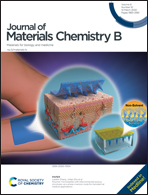Cytotoxic and osteogenic effects of crocin and bicarbonate from calcium phosphates for potential chemopreventative and anti-inflammatory applications in vitro and in vivo
Abstract
Delayed healing and nonhealing of bone defects or resected bone sites remains an important clinical concern in the biomedical field. Osteosarcoma is one of the most common types of primary bone cancers. Among calcium phosphates, hydroxyapatite (HA) and tricalcium phosphate (TCP) are the most widely used in various biomedical applications for bone reconstruction and replacement. In this study, crocin, saffron's natural bioactive and anti-inflammatory molecule, and bicarbonate, a neutralizing agent, were directly loaded onto HA disks to evaluate their in vitro release and effect on human osteoblast and osteosarcoma cell lines. This was assessed through release, initial toxicity, drug optimization, final toxicity studies and in vivo anti-inflammatory assessment through H&E indexing. It is hypothesized that the release of crocin, bicarbonate, and the dual release of both agents will decrease osteosarcoma cellular viability with no effect on osteoblast cells. A plateaued release of crocin and bicarbonate was achieved over seven weeks in physiological and acidic environments, where bicarbonate was shown to modulate the release of crocin. Through morphological characterization and MTT assay analysis, bicarbonate showed no toxicity to human fetal osteoblast (hFOB) cells and crocin significantly enhanced osteoblast proliferation. Through drug concentration optimization, all drug loaded samples decreased human osteosarcoma (MG-63) viability by 50% compared to control samples by Day 11, with clear changes in cell spreading and morphology. Moreover, 3D printed TCP scaffolds loaded with crocin and bicarbonate were tested in vivo in order to assess their preliminary effects on inflammation in a rat distal femur model at 4 days. Lower inflammatory cellular recruitment was achieved in the presence of crocin and bicarbonate, compared to the control. These results suggest a pro-apoptotic mechanism against osteosarcoma as well as anti-inflammatory properties of crocin and bicarbonate, elucidating a potential application for osteosarcoma regulation and wound healing for bone tissue regeneration applications.



 Please wait while we load your content...
Please wait while we load your content...